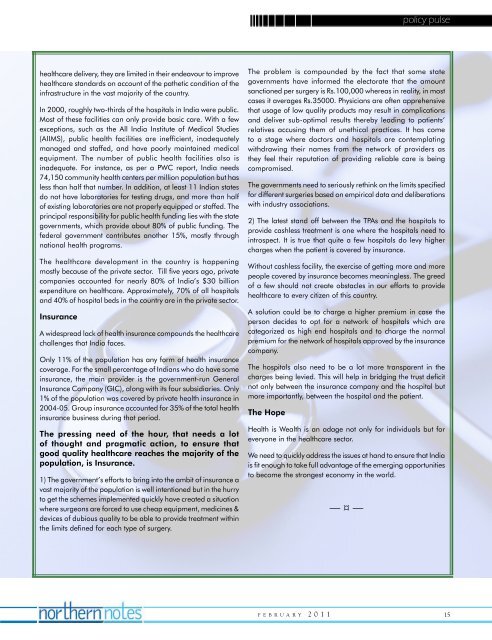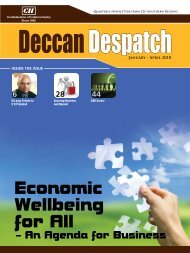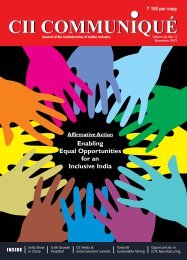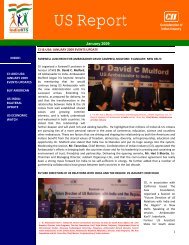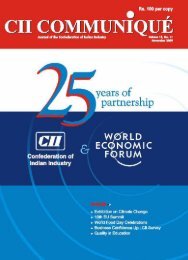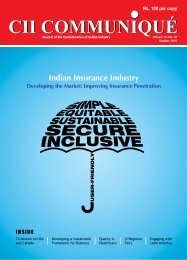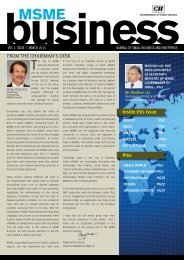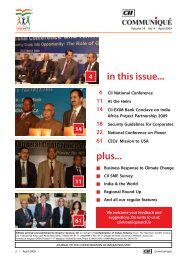Create successful ePaper yourself
Turn your PDF publications into a flip-book with our unique Google optimized e-Paper software.
policy pulsehealthcare delivery, they are limited in their endeavour to improvehealthcare standards on account of the pathetic condition of theinfrastructure in the vast majority of the country.In 2000, roughly two-thirds of the hospitals in India were public.Most of these facilities can only provide basic care. With a fewexceptions, such as the All India Institute of Medical Studies(AIIMS), public health facilities are inefficient, inadequatelymanaged and staffed, and have poorly maintained medicalequipment. The number of public health facilities also isinadequate. For instance, as per a PWC report, India needs74,150 community health centers per million population but hasless than half that number. In addition, at least 11 Indian statesdo not have laboratories for testing drugs, and more than halfof existing laboratories are not properly equipped or staffed. Theprincipal responsibility for public health funding lies with the stategovernments, which provide about 80% of public funding. Thefederal government contributes another 15%, mostly throughnational health programs.The healthcare development in the country is happeningmostly because of the private sector. Till five years ago, privatecompanies accounted for nearly 80% of India’s $30 billionexpenditure on healthcare. Approximately, 70% of all hospitalsand 40% of hospital beds in the country are in the private sector.InsuranceA widespread lack of health insurance compounds the healthcarechallenges that India faces.Only 11% of the population has any form of health insurancecoverage. For the small percentage of Indians who do have someinsurance, the main provider is the government-run GeneralInsurance Company (GIC), along with its four subsidiaries. Only1% of the population was covered by private health insurance in2004-05. Group insurance accounted for 35% of the total healthinsurance business during that period.The pressing need of the hour, that needs a lotof thought and pragmatic action, to ensure thatgood quality healthcare reaches the majority of thepopulation, is Insurance.1) The government’s efforts to bring into the ambit of insurance avast majority of the population is well intentioned but in the hurryto get the schemes implemented quickly have created a situationwhere surgeons are forced to use cheap equipment, medicines &devices of dubious quality to be able to provide treatment withinthe limits defined for each type of surgery.The problem is compounded by the fact that some stategovernments have informed the electorate that the amountsanctioned per surgery is Rs.100,000 whereas in reality, in mostcases it averages Rs.35000. Physicians are often apprehensivethat usage of low quality products may result in complicationsand deliver sub-optimal results thereby leading to patients’relatives accusing them of unethical practices. It has cometo a stage where doctors and hospitals are contemplatingwithdrawing their names from the network of providers asthey feel their reputation of providing reliable care is beingcompromised.The governments need to seriously rethink on the limits specifiedfor different surgeries based on empirical data and deliberationswith industry associations.2) The latest stand off between the TPAs and the hospitals toprovide cashless treatment is one where the hospitals need tointrospect. It is true that quite a few hospitals do levy highercharges when the patient is covered by insurance.Without cashless facility, the exercise of getting more and morepeople covered by insurance becomes meaningless. The greedof a few should not create obstacles in our efforts to providehealthcare to every citizen of this country.A solution could be to charge a higher premium in case theperson decides to opt for a network of hospitals which arecategorized as high end hospitals and to charge the normalpremium for the network of hospitals approved by the insurancecompany.The hospitals also need to be a lot more transparent in thecharges being levied. This will help in bridging the trust deficitnot only between the insurance company and the hospital butmore importantly, between the hospital and the patient.The HopeHealth is Wealth is an adage not only for individuals but foreveryone in the healthcare sector.We need to quickly address the issues at hand to ensure that Indiais fit enough to take full advantage of the emerging opportunitiesto become the strongest economy in the world.— ¤ —f e b r u a r y 2 0 1 115


